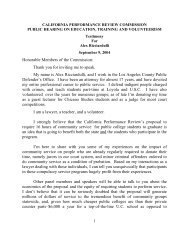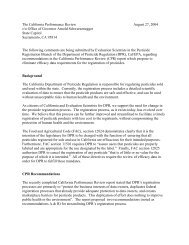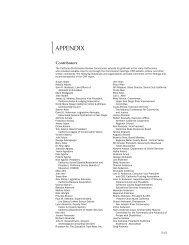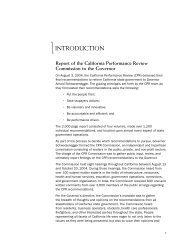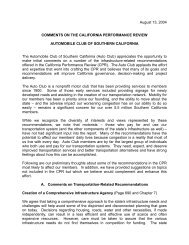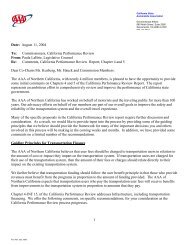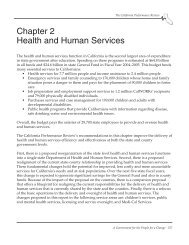Chapter 1 General Government - The California Performance Review
Chapter 1 General Government - The California Performance Review
Chapter 1 General Government - The California Performance Review
- No tags were found...
Create successful ePaper yourself
Turn your PDF publications into a flip-book with our unique Google optimized e-Paper software.
GG 07Maximize Federal Grant Funds<strong>The</strong> <strong>California</strong> <strong>Performance</strong> <strong>Review</strong>Summary<strong>California</strong> does not receive its fair share of federal grant funds. To increase federal grant funds,all of the state’s grant activities related to determining eligibility for or receiving federal grantsshould be consolidated in a single entity.Background<strong>The</strong> federal government distributed more than $362 billion in various formula-driven andspecial grant funds to state and local entities in Fiscal Year 2001–2002. <strong>California</strong>’s share oftotal federal grants awarded was 11.8 percent, or $42.7 billion. Ninety-five percent of<strong>California</strong>’s share of grants is received for such programs as Medicaid, highways, welfare,education assistance and nutrition programs. <strong>The</strong>se grants generally use congressionallydeveloped formulas, often based on some combination of population, income, poverty, orsimilar data. 1<strong>California</strong> is simultaneously poor, wealthy, young, urban and immigrant. 2 <strong>California</strong>’s uniquepopulation makeup results in formula calculations that do not represent the state’s populationcharacteristics. Some formula grants distribute funding based on population data and thechoice of the year for which population is analyzed can significantly influence grant amounts.For example, a recent audit conducted by the <strong>California</strong> Bureau of State Audits found thatfederal grants received by <strong>California</strong> in FY 2001–2002 were $5.3 billion less than an allocationbased on population share alone. 3 If current population data had been used to compute federalformula grants, <strong>California</strong> would have received more than $48 billion in federal funds ratherthan $42.7 billion actually received.Funding formulas that do not allocate funds based on accurate population data result in lowergrant funding for large states like <strong>California</strong>. For example, the federal Workforce InvestmentAct provides federal funds to administer the state’s job training and workforce preparationsystem. <strong>The</strong> funding formula for this program requires that 1999 census data be used tocompute <strong>California</strong>’s share of grant funds. If more current available census data were used,<strong>California</strong> would have received an additional $30 million in FY 2003–2004. 4In federal FY 2001–2002, <strong>California</strong> sent $58 billion more to Washington in federal taxes thanthe state received back in federal spending. 5 This equates to <strong>California</strong> receiving 77 cents infederal payments and services for every dollar sent to Washington. 6<strong>California</strong> does not have an established process to analyze and revise the impact that formulagrants have on its economy and services provided until after the state’s fiscal year ends. 7 Thisdirectly impacts various populations served and the level of services provided to them. <strong>The</strong>A <strong>Government</strong> for the People for a Change 37



